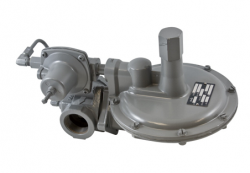Product Description
CL31 Regulator
Features + Benefits
Some of the features of the CL31 include:
- Controlled size pilot breather orifice eliminates pulsation and provides normal breathing operations
- “Stop stem” in pilot insures token internal relief valve operation
- No special start-up procedures
The versions available with the CL31 are:
- CL31N – The CL31N is a constant pressure loaded regulator that utilizes a pilot with no internal relief (N). This regulator can be used where psig to psig regulation is required with no internal relief
- CL31R – The CL31R is a constant pressure loaded regulator equipped with a pilot internal relief valve. The pilot relief valve is not designed for “full capacity” relief, but rather to limit the loading chamber pressure to a safe value in the event of a failure
- CL31IMN – The CL31IMN is a constant pressure loaded regulator featuring Internal Monitoring (IM) operation with no pilot internal relief (N). It provides the important added advantage of a second, bubble-tight lock-up seat in series with the primary seat. If the primary seat fails to close or control the gas flow, the Internal Monitor seat assumes control of the downstream gas pressure
- CL31IMR – The CL31IMR provides the same features as the ‘IMN’ model but with token pilot relief valve backup of the monitor orifice if both the primary seat and monitor seat fail simultaneously
- CL31IMRV – Operation is identical to the ‘IMR’ except that at no flow position of the monitor orifice a small volume of gas is vented through the relief valve to serve as a signal that the regulator is on monitor operation and the primary seat has failed. No gas is vented until the gas load is less than the volume going through the orifice vent hole and the regulator is on monitor operation














 Công Ty TNHH Thiết Bị Công Nghiệp Sao Việt chuyên cung cấp máy móc, thiết bị, phụ tùng các loại máy, kết hợp với các dịch vụ lắp đặt sửa chữa, bảo trì các loại máy móc, thiết bị công nghiệp.
Công Ty TNHH Thiết Bị Công Nghiệp Sao Việt chuyên cung cấp máy móc, thiết bị, phụ tùng các loại máy, kết hợp với các dịch vụ lắp đặt sửa chữa, bảo trì các loại máy móc, thiết bị công nghiệp.